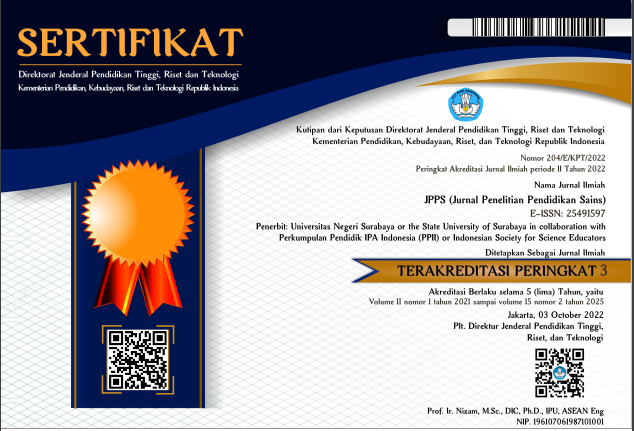Practicality of Web-Based Four-Tier Test to Identify Student's Misconceptions in Chemical Bonding Materials
DOI:
https://doi.org/10.26740/jpps.v12n2.p108-121Keywords:
Chemical bonds, Education, Four tier test , Misconceptions , WebsiteAbstract
Misconceptions can be identified using a four-level test format diagnostic test. However, this test is less effective because it still uses paper/print and requires a long time at the correction stage. Therefore, it is necessary to develop a web-based four-level test. Objective: The purpose of this research is to find out the practicality of a web-based four-level test. Methods: This type of research is descriptive quantitative with data sources from class X MIPA MAN 1 Hulu Sungai Tengah. The data collection technique uses a questionnaire to test practicality. Results: The results of the practicality test obtained an average percentage of 82.5% in the very practical category in aspects of web appearance, image clarity, material suitability, language, paperless, and helping to determine students' abilities and weaknesses in chemical bonding material. Based on this assessment, a web-based four-level practice test product was used to identify misconceptions in class X MIPA MAN 1 Hulu Sungai Tengah. While the results of students' misconceptions on Lewis structure indicators in chemical compounds were 49.21%, ionic bond formation indicators were 39.68%, covalent bond formation indicators were 47.09%, polar covalent compound indicators were 38.89%, metallic bond indicators were 39.42%, and indicators of the physical properties of compounds based on their bonds of 46.03%. All percentages on these indicators include medium criteria. Novelty: Previous researchers have never done this research, which measured students' misconceptions with web-based four-tier tests in chemistry concepts.
Downloads
References
Annisa, A. R., Putra, A. P., & Dharmono, D. (2020). Kepraktisan media pembelajaran daya antibakteri ekstrak buah sawo berb asis macromedia flash. Quantum: Jurnal Inovasi Pendidikan Sains, 11(1), 72. https://doi.org/10.20527/quantum.v11i1.8204
Chen, X., Zou, D., Cheng, G., & Cheng, G. (2020). Detecting latent topics and trends in educational technologies over four decades using structural topic modeling: a retrospective off all volumes of computers & education. Computer & Education, 151(103855). https://doi.org/10.1016/j.compedu.2020.103855
Effendy. (2016). Ilmu kimia untuk siswa SMA dan MA kelas X. Lamongan: Indonesian Academic Publishing.
Murniningsih, M, K., & Irawati, R. K. (2020). Analysis of misconceptions by four tier tests in electrochemistry, case study on students of the chemistry education study program UIN Antasari Banjarmasin. Journal of Physics: Conference Series, 1440(1), 012008. https://doi.org/10.1088/1742-6596/1440/1/012008
Peprizal, P., & Syah, N. (2020). Pengembangan media pembelajaran berbasis web pada mata pelajaran instalasi penerangan listrik. Jurnal Imiah Pendidikan dan Pembelajaran, 4(3), 455-467. https://doi.org/10.23887/jipp.v4i3.28217
Septiyana, E. (2019). Identifikasi miskonsepsi siswa menggunakan tes diagnostik four-tier digital test (4TDT) berbasis website pada konsep suhu dan kalor) [Skripsi]. Fakultas Ilmu Tarbiyah dan Keguruan UIN Syarif Hidayatullah Jakarta.
Warsito, J., Subandi, S., & Parlan, P. (2021). Identifikasi miskonsepsi siswa pada topik ikatan kimia serta perbaikannya dengan pembelajaran model ECIRR (elicit, confront, identify, resolve, reinforce). Jurnal Pendidikan: Teori, Penelitian, dan Pengembangan, 5(11), 1563. https://doi.org/10.17977/jptpp.v5i11.14158
Downloads
Published
How to Cite
Issue
Section
License
Copyright (c) 2023 JPPS (Jurnal Penelitian Pendidikan Sains)

This work is licensed under a Creative Commons Attribution-ShareAlike 4.0 International License.
 Abstract views: 535
,
Abstract views: 535
, PDF Downloads: 568
PDF Downloads: 568












